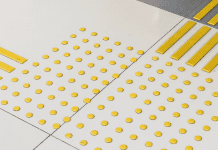New York-based civil engineering firm Sullivan Engineering onboarded FlowForma’s process automation technology to save time and increase operational efficiency in their business
Sullivan Engineering specialises in exterior restoration services, so-called ‘envelope work’ that includes façade restoration, roofing, and window replacement. Much in demand, the company’s 60 full-time employees run and execute multiple construction contracts simultaneously.
As the company grew, project oversight became more of a challenge. To save time and increase operational efficiency, the firm was looking to digitise reporting processes and move away from excessive paperwork that let mistakes slip through and slowed down project completion.
“We were trying to track different things in Excel and on paper. It got very messy and not everyone had the same access to printers so digitising processes was a must.” – Jimmy Monahan, Principal Building Envelope Consultant.
The company spent three months researching the best platform. FlowForma was the perfect fit.
Anthony Ngadimin, Sr. Building Envelope Consultant was involved in the procurement and saw the time-saving advantages immediately: “I used to try and automate processes using Python and other programming languages and it could take months.
The logic is still there with FlowForma, but you don’t have to learn any code or any syntax, which is great. That’s what drew us to the solution in the first place.”
How process automation was used
Field Reports was next, a flow used to provide a detailed record of site visits. Previously, punch lists, bills of quantities, and costs were assembled along with site photographs on handheld devices. Reports were created using different types of documents, culminating in a PDF with handwritten notes. The process was digitised as a templated form with all inputs residing in one place.
The Field Report also provided the structure for Weekly Investigation Reports, used for updates and project milestones or for more granular reporting on specialist areas, like a roof survey.
Having a templated approach halves the time it takes to come up with new reports, according to Jimmy Monahan. The Covid checklist was created in less than a day; the more complicated Field Report in just under a week.
FlowForma helped Sullivan Engineering to significantly reduce time
Rolling out FlowForma to new users took the company a quarter of the time it took to deploy other solutions and the outcomes have been game-changing. Monahan described how it is much easier to review processes and train people on them; how everything is in one place with seamless document control, as opposed to old processes where there could be multiple versions in different places.
“Tracking changes is much easier than trying to write them on a PDF, and we don’t have to have administrators making the same change repeatedly. You make it once in the master template and it’s applied to all your other reports.” he said.
Project review process times have been halved
The time-saving benefits for the business cannot be underestimated. “Efficiency and productivity are really important because construction is such a fast-paced business,” said Anthony Ngadimin.“The faster we can get reports out, the happier the clients and the more projects we can take on.”
Project review processes are completed in half the time – one day as opposed to two – and help catch problems before they become an issue. “We’re doing more at the front end, like uploading site photographs straight into FlowForma. Huge time-saving leads to cost savings, and that allows us to take on almost twice as many deliverables as we normally would,” said Jimmy Monahan.
FlowForma has enabled Sullivan Engineering to meet increasing market demand
Like a lot of organisations, Sullivan Engineering is now rethinking its processes. It has succeeded in its plan to reduce paperwork in the business and is using digitisation to do things differently. Crucially, FlowForma has enabled it to scale and meet increasing market demand.
The company had grown too big for processes to exist in a handful of people’s heads. FlowForma has helped create a knowledge repository, where templates provide a repeatable way of doing things that don’t have to be constantly taught and relearned. Jimmy explains ‘‘When you scale when people are working remotely and can’t easily relay information to teammates, there’s a risk people will do things differently. Digitising in FlowForma has solved that by creating a centralised repository. It means we’re not constantly reinventing the wheel.”
Download the full case study here.

















